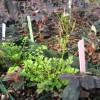Abstract
Bittercress commonly grows in the potting media of container-grown ornamentals and often through drainage holes in nursery containers. It also can be a problem in propagation houses, greenhouses, and in the field. This 6-page fact sheet provides species description, plant biology, and management recommendations. Written by Chris Marble, Shawn Steed, and Nathan S. Boyd, and published by the UF Department of Environmental Horticulture, December 2014.
References
Bachman, G., and T. Whitwell. 1994. "Hairy Bittercress (Cardamine hirsuta) Seed Production and Dispersal in the Propagation of Landscape Plants." Proc. Southern Nurs. Assoc. Res. Conf. 39: 299-302.
Clapham, A. R., T. G. Tutin, and D. M. Moore. 1987. Flora of the British Isles, 3rd edition. Cambridge, UK: Cambridge University Press.
Neal, J. C., and J. F. Derr. 2005. Weeds of container nurseries in the United States. Raleigh, NC: North Carolina Assoc. of Nurserymen, Inc.
Richardson, B., C. H. Gilliam, G. Fain, and G. Wehtje. 2008. "Container Nursery Weed Control with Pinebark Mini-Nuggets." Journal of Environmental Horticulture 26: 144-148. https://doi.org/10.24266/0738-2898-26.3.144
USDA National Resources Conservation Service. 2014. The PLANTS database. http://plants.usda.gov.

